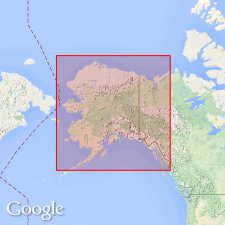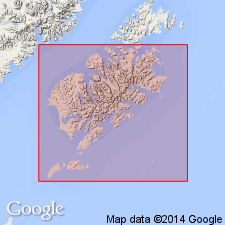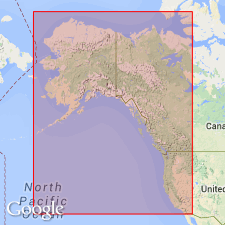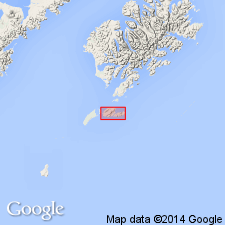
- Usage in publication:
-
- Narrow Cape Formation*
- Modifications:
-
- Named
- Biostratigraphic dating
- Dominant lithology:
-
- Sandstone
- Conglomerate
- Siltstone
- AAPG geologic province:
-
- Alaska Southwestern region
- Kodiak province
Summary:
Named for Narrow Cape near east end of Kodiak Island, AK. Type section designated along southwest coast of Narrow Cape from its end northwestward about 1 km to axis of syncline, Kodiak Island. Lower two-thirds consist of sandstone and few conglomerate beds; upper one-third is siltstone. Is about 700 m thick at type. Conformably overlies Sitkinak Formation (new); unconformably overlies Sitkalidak Formation (new) at Narrow Cape. At type contains rich marine fauna identified by F.S. MacNeil (written commun., 1963) to be middle Miocene age. Fossils collected near base of unit on Sitkinak Island were determined by MacNeil to be early Miocene. Age of unit considered to be Miocene.
Source: GNU records (USGS DDS-6; Menlo GNULEX).

- Usage in publication:
-
- Narrow Cape Formation*
- Modifications:
-
- Age modified
- AAPG geologic province:
-
- Alaska Southwestern region
- Kodiak province
Summary:
Age of Narrow Cape Formation is middle Miocene on basis of marine mollusk.
Source: GNU records (USGS DDS-6; Menlo GNULEX).

- Usage in publication:
-
- Narrow Cape Formation*
- Modifications:
-
- Age modified
- AAPG geologic province:
-
- Alaska Southwestern region
- Kodiak province
Summary:
Narrow Cape Formation on Sitkinak Island considered to be late Oligocene or earliest Miocene by Allison (1976, 1st International Congress of Pacific Neogene Stratigraphy, Tokyo, p.10-13)
Source: GNU records (USGS DDS-6; Menlo GNULEX).

- Usage in publication:
-
- Narrow Cape Formation*
- Modifications:
-
- Age modified
- AAPG geologic province:
-
- Alaska Southwestern region
- Kodiak province
Summary:
At Narrow Cape on Kodiak Island, age of unit is early and middle Miocene (Allison, 1976) and unit overlies with angular unconformity Sitkalidak and Ghost Rocks Formations. On Sitkinak Island age of unit is late Oligocene or early Miocene (Allison, 1976) and unit conformably overlies Sitkinak Formation (Oligocene). Therefore age is late Oligocene(?) to middle Miocene.
Source: GNU records (USGS DDS-6; Menlo GNULEX).

- Usage in publication:
-
- Narrow Cape Formation*
- Modifications:
-
- Biostratigraphic dating
- AAPG geologic province:
-
- Alaska Southwestern region
- Kodiak province
Summary:
Type Narrow Cape Formation on Kodiak Island assigned to Newportian (late early and early middle Miocene) by Allison (1978, The Veliger v.21 no.2 p.171-188) based on correlation of molluscan fauna.
Source: GNU records (USGS DDS-6; Menlo GNULEX).

- Usage in publication:
-
- Narrow Cape Formation*
- Modifications:
-
- Areal extent
- Age modified
- Biostratigraphic dating
- AAPG geologic province:
-
- Alaska Southwestern region
- Kodiak province
Summary:
Narrow Cape Formation is geographically restricted from Sitkinak Island; strata are reassigned to the informally named siltstone of Trinity Islands. Age is early middle Miocene on basis of contained molluscan fauna.
Source: GNU records (USGS DDS-6; Menlo GNULEX).
For more information, please contact Nancy Stamm, Geologic Names Committee Secretary.
Asterisk (*) indicates published by U.S. Geological Survey authors.
"No current usage" (†) implies that a name has been abandoned or has fallen into disuse. Former usage and, if known, replacement name given in parentheses ( ).
Slash (/) indicates name conflicts with nomenclatural guidelines (CSN, 1933; ACSN, 1961, 1970; NACSN, 1983, 2005, 2021). May be explained within brackets ([ ]).

